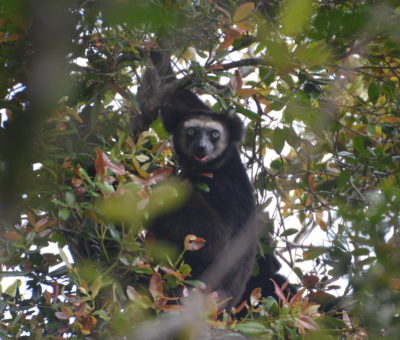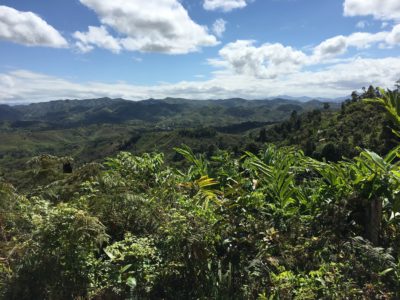There has been much recent debate over the extent to which Madagascar forest cover has disappeared over time. Some estimate that around 80 to 90% of the forest cover is gone (1), while others argue that the number is actually smaller, although still significant (2).
Research Summary
Until recently, it was widely accepted that Madagascar has lost 90% of its forest cover. We now understand that this claim is most likely over-exaggerated, as it is heavily based on unreliable 18th century research. Imaging technology and modern botanical research has helped to produce more accurate estimates that Madagascar has actually lost 50% or less of its original forest cover. Additionally, the 90% claim is harmful to the reputation and wellbeing of rural Malagasy people.

Indris in Anjanaharibe Sud Special Reserve By Lynne Venart
According to McConnell and Kull (2014), it is difficult to measure the net loss of forest cover due to the messy process of integrating conflicting and problematic historical data, satellite imagery, and air photos.
It’s important to note that the 90% loss of forest cover estimate is based on flimsy, biased, and poorly obtained data from 18th century scientific reports (2).
McConnell and Kull (2014) suggest a way to calculate a more accurate estimate of the change over time of the island’s forest cover in order to correct exaggerated and problematic claims about deforestation. By taking into consideration the sociological and historical context of past research, they propose a method for more accurately synthesizing information related to the following two key components for determining the level of deforestation in Madagascar:
-
Historical accounts of forest cover compared to more recently published data
-
The development of newer and more precise technologies for measuring the land
What We Know about Madagascar’s Historical Landscapes
At first glance, the literature seems to suggest that we don’t know what Madagascar’s original landscapes really looked like historically or pre-historically. Some colonial research claims the entire island was completely covered in forest (3), while others argue that the grasslands and other non-forest biomes actually existed before human presence on the island (4).

En Route to Anjanaharibe Sud By Lynne Venart
However, there is now quite a bit of empirical evidence to support the latter claim, that Madagascar was originally made up of several different biomes even before humans inhabited the island (4,5).
It is also most likely true that many colonial accounts of the geography of Madagascar are biased and were designed to paint the indigenous Malagasy people in a negative light (2). Additionally, much of this colonial ‘research’ was based on casual observations of the land rather than extensive and accurate mapping (3,6).
Therefore, the island was most likely not 100% forested to begin with (2).
Determining How Much of Madagascar’s Forest has Disappeared
We know that Madagascar has lost some amount of forest cover (7,8,9), but how can we quantify this loss?
To put it simply, it’s complicated. According to McConnell and Kull (2014), this calculation is rather involved and requires a “careful, evidence-based [approach]” that integrates modern and historical imaging technology with botanical data. This analysis cannot rely entirely on outdated colonial claims.
So what is the actual estimate?
“…as much as half – but perhaps much less – of the most easily identified ‘primary’ forest types changed to other land covers during the latter half of the twentieth century (2).”
Thanks to recent research, we also know that between 1995 and 2011, 11% of forest cover on Madagascar has decreased (10).
What is so bad about the claim that ‘90%’ of the forest has been lost?
The exaggerated claim that Madagascar has lost 90% of its forest can be problematic. Its inaccuracy undermines genuine scientific efforts and causes problems for Malagasy people. It has fueled conservation policies that often disparage rural people, silence their voices, and restrict their ability to access resources (2).
“The discourse paints Madagascar first and foremost as a hot spot of biological diversity, environmental degradation, and conservation action. It often relies on a narrative whose roots go directly back to the work of Perrier de la Bâthie and Humbert in the 1920s and 1930s. The story, as they framed it, begins with the original island-wide forest, and then blames the agricultural practices of Malagasy farmers as the primary cause of deforestation, together with colonial logging (2).”
Sources
- Volampeno, M. Sylviane N., Judith C. Masters, and Colleen T. Downs. “A population estimate of blue-eyed black lemurs in Ankarafa Forest, Sahamalaza-Iles Radama National Park, Madagascar.” Folia Primatologica 81, no. 5 (2010): 305-314.
- McConnell, W. J. and Kull, C.A.. “Deforestation in Madagascar,” in Conservation and environmental management in Madagascar, edited by Ivan R. Scales, 67-104. Routledge, 2014.
- Perrier De la Bathie, Henri. “La végétation malgache.” In Annales du musée colonial de Marseille, vol. 3, pp. 1-268. 1921.
- Quéméré, Erwan, Xavier Amelot, Julie Pierson, Brigitte Crouau-Roy, and Lounès Chikhi. “Genetic data suggest a natural prehuman origin of open habitats in northern Madagascar and question the deforestation narrative in this region.” Proceedings of the National Academy of Sciences 109, no. 32 (2012): 13028-13033.
- Virah‐Sawmy, Malika. “Ecosystem management in Madagascar during global change.” Conservation Letters 2, no. 4 (2009): 163-170.
- De La Bathie, Perrier. “Biogéographie des plantes de Madagascar.” (1936).
- Guichon, A. “La superficie des formations forestières de Madagascar.” Revue forestière française (1960).
- Nelson, Ross, and Ned Horning. “AVHRR-LAC estimates of forest area in Madagascar, 1990.” TitleREMOTE SENSING 14, no. 8 (1993): 1463-1475.
- McConnell, William J. “Madagascar: Emerald isle or paradise lost?.” Environment: Science and Policy for Sustainable Development 44, no. 8 (2002): 10-22.
- Zaehringer, Julie G., Sandra Eckert, and Peter Messerli. “Revealing regional deforestation dynamics in North-Eastern Madagascar—Insights from multi-temporal land cover change analysis.” Land 4, no. 2 (2015): 454-474.

Katie Hallsten
About the Author
Katie Hallsten is a primate cognition researcher and MSc student at the University of St. Andrews where she studies planning behavior and physical cognition in chimpanzees, orangutans, and macaque monkeys.
She is dedicated to conserving the world’s most endangered primates and hopes to inspire others to do the same.




